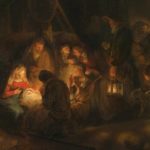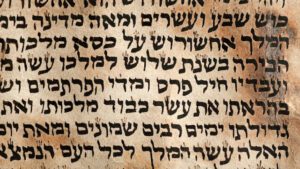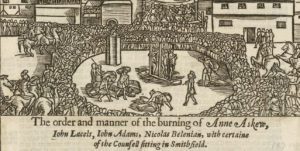Part 3 of TGCA’s series on The Apostle’s Creed
At the beginning of the the second article of the Creed, we learn how it is that we may believe the Almighty Creator to be our Father—namely, through what we believe about his Son. The earliest recorded forms of the Church’s rule of faith[1] confess trust in God’s Son, Jesus Christ our Lord. Of course, this is simply a rehearsal of what the Apostles had preached since Pentecost:
Therefore let all the house of Israel know with certainty that God has made this Jesus, whom you crucified, both Lord and Messiah. (Acts 2:36)
The Almighty Creator vindicates Jesus by raising him from the dead and designates him as the long-awaited son of David and the Son of God
In the power of his Spirit, the Almighty Creator vindicates the crucified Jesus of Nazareth by raising him from the dead and designates him as the long-awaited son of David and the Son of God (Rom.1:3-4). In this essay, we shall reread the Bible story to see how Peter and Paul’s summary statements act as foundations for the Creed: that we believe in Jesus as the Christ of history and, as the Son of God, the Lord of promise.[2]
Jesus the Son as the Christ of History
From the Apostolic witness to the resurrection and in the power of the Holy Spirit, we believe in Jesus Christ. Sometimes forgotten, it bears repeating that Christ is not a surname but a title. We believe that Jesus is the Christ which means we believe he is God’s Spirit-empowered, ruler of Israel, the Messiah and Son of God. Where do we look to help us unpack this?
At the beginning of the Gospels stories we learn that the son of Mary will be born into the line of David (Mat.1:1-16 c.f. Lk.3:23-38). More so, in Luke’s account, the angel informs Mary that she will bear a son whom ‘the Lord God will give … the throne of his father David.’ (1:32) Furthermore, Jesus will not be just another son in the line of David: the angel brings word that in him—as the son of David—the full extent of God’s promise will be fulfilled: ‘He will … be called the Son of the Most High … and he will reign over the house of Jacob forever, and of his kingdom there will be no end’ (1:32–33 ).
From the perspective of the Old Testament, this is exactly what we expect for the son of David given the promise that God made to Israel’s great king:
I will raise up after you your descendant, who will come from your body, and I will establish his kingdom… I will be a father to him, and he will be a son to Me… Your house and kingdom will endure before Me forever, and your throne will be established forever. (2 Sam. 7:12-14,16)
The ‘Son-of-the-Most-High’ and ‘kingdom-with-no-end’ nature of Jesus’ Messianic role will mark the perfection of God’s promises to David. Jesus will be the son of David whom God will call his own and there will be none to succeed him in that line.
Jesus the son as a David-type of Messiah
There is more to the ultimate nature of Jesus of Nazareth as the Messiah of God. If we look more closely at the Old Testament we see that David is not merely Jesus’s ancestor but also a narrative type of the kind of Messiah that Jesus will be. The Samuel narratives tell of the prophet realising God’s choice of monarch for Israel through a secret anointing of David.
In what follows, a basic type for God’s Messiah unfolds. He is anointed by Samuel—an event that brings him into special relationship with God as king (1 Sam 10:1; 16:13) and marks him as the subject of deliberate divine choice (1 Sam. 9:16; 16:1).
At the same time, the Messiah is empowered for office with the Holy Spirit (including for prophecy) and, finally, performs mighty acts in public showing himself as God’s chosen one (1 Sam. 11; 17). Even the Messiah as God’s chosen ruler of Israel belongs to a larger story.
Jesus the son as Kinsman Redeemer
The mighty acts of the Messiah can be seen as an expansion and extension of the anointing given to a Judge from the conquest period. Like the Judges, the Messiah is a charismatic individual, chosen out of Israel and empowered to save God’s people. However, instead of a single tribe, the Messiah saves the whole nation from its enemies. In fact, Psalm 72:14 even refers to the king as the kinsman redeemer (gō’ēl c.f. Ruth 3:8). Thus we read in 2 Samuel 7:1:
When the king had settled into his palace and the Lord had given him rest on every side from all his enemies. (c.f. 2 Sam 7:9–11)
The Messiah as kinsman redeemer is ‘a point of unity for Israel as a whole.’[3] David’s anointing (2 Sam 5:1–3; 1 Chr 11:1–3, 13–28), his victory over the Jebusites (1 Chr 11:4) and the installation of the ark (2 Sam. 6; 1 Chr. 13;15) each involve ‘all Israel’. Going back to the royal covenant of 2 Samuel 7 we see that in verses 6–16 the fortunes of David are intertwined with the unfolding history of Israel, ‘the promises are given to David as Israel’s representative.’[4]
When the Lord delivers victory into the hands of the Messiah, the people and the land flourish.
Throughout the 1 Samuel narrative to this point David has been the agent delivering the rest that the exodus deliverance anticipated. Hence the Davidic promise of 2 Samuel 7 also carries with it the flavour of the promises that the Lord made to Abraham in Genesis 12:1–3. According to 2 Samuel 7:9–11, the Lord will make David’s name great (v. 9), provide a place for Israel (v. 10; note the description of the borders in comparison with Gen 15:18) and will give David rest from his enemies (v. 11a). At the very least, as we read in Ps 72:1-4, the hope of the people lies in this relationship between God and the king. When the Lord delivers victory into the hands of the Messiah, the people and the land flourish.
When God raised the crucified Jesus of Nazareth to life, the Holy Spirit vindicated him as the triumphant son of David par excellence who has ‘[saved] his people from their sins.’ (Mat1:21) Jesus was commissioned with the Spirit at his baptism (Mat 3:16; Mark.1:9; Luke 3:21), defeated the Satan (Mat 4:1-11; Mark.1:12&13; Luke 4:1-13) prophesied (e.g. Luke 4:18&19 c.f. Is 60:1-2) and performed ‘miracles, wonders, and signs.’ (Acts 2:22) As the son of God, Jesus (the son of David) is the mediator by whom God saves his people. Of course, even as the everlasting Messiah, we believe that Jesus is also the Son of God in a unique and personal way.
Jesus the Son as the Lord of Promise
Let’s go back to the opening of the Gospel accounts. Here the mother of Jesus is to give him a special name, ‘Immanuel; which means God with us.’ (Mat 1:23 c.f. Is 7:14). Furthermore, Joseph her husband is instructed to name the child Jesus, because ‘he will save his people from their sins.’(Mat 1:21) On this basis alone, it is tempting to read the larger Israelite story themes straight into the Gospel accounts—the Lord will be present to save! Yet as Calvin warns, it is a mistake to conflate the name YHWH with the name Jesus at such an early point of the narrative[5]—we must look to other clues.
The possibility of God’s personal presence in the man Jesus of Nazareth is developed in the Gospels through various allusions to the Tabernacle in the OT and the ongoing relationship between Jesus and the Temple throughout. So, in the prologue of John, we read that the Logos (who is God) dwelt among us (John 1:14) and in Gabriel’s announcement to Mary the virgin is told that ‘The Holy Spirit will come upon you and power from the Most High will overshadow you’ (Luke 1:35). In John’s case, the Apostle describes the incarnation using language reminiscent of the depiction of the Tabernacle in Ex 25—the place in which YHWH would dwell with his people. Furthermore, the ‘overshadowing’ language in Luke’s account is similar to the language used to describe the personal glory of YHWH settling on the Tabernacle (Ex 40:35). These allusions are made concrete when Jesus himself makes an explicit association between his body and the Temple:
Destroy this temple and in three days I will raise it. The Jews replied, ‘It took forty-six years to build this temple and you will raise it up in three days?’ But he was referring to the temple of his body. (John 2:19–21; c.f. Mat 12:6)
Jesus appears (gloriously) in the presence of Moses and Elijah, both of whom experienced the presence of YHWH on a mountain.
The account of the transfiguration contains more clues for us to reflect on the presence of YHWH in the person of Jesus (Mat 17:1–7; Mark 9:2–10; Luke 9:28–37). Jesus and three disciples go up a mountain to pray and God addresses the transformed Jesus as his chosen Son. Jesus appears (gloriously) in the presence of Moses and Elijah, both of whom experienced the presence of YHWH on a mountain (Sinai: Ex 24:15-16; Horeb: 1 Kings 19:8–9). What’s more, as he once spoke to Moses and Elijah in the clouds upon a mountain, God now speaks directly to the disciples, endorsing Jesus as his Son (Luke 9:35).[6]
The question of YHWH’s presence in the person of Jesus is nowhere more pressing than at the climax of the Gospel accounts—the cross of Golgotha. Here the Messiah appropriates the words of the Psalm 22 to frame his experience for the witnesses (Matthew’s account, in particular, is peppered with allusions to this lament). Most notably, Jesus cries out, ‘My God, my God, why have you forsaken me?’ The distortion of the world order that marks the death of this man, Jesus of Nazareth, (darkness and earthquakes) ought to be a sign that God had departed from that place.
Significantly though, Jesus’ words about the Temple come back to haunt him at the foot of the cross: ‘You who are going to destroy the temple and build it in three days, save yourself! Come down … if you are the Son of God!’ (Mat 27:40). The taunt reflects the mischievous charges brought against Jesus at his trial, ‘We heard him say, “I will destroy this temple made with human hands and in three days will build another, not made with hands.”’ (Mark 15:58). At the very least the question of God’s presence, the Temple and the Christ remain intertwined to the last for it was conflict with the authorities about the Temple that bought him to Golgotha.
Especially in the synoptic accounts, the temple cleansing separates Jesus’ triumphal entry into Jerusalem as Zecharaiah’s Messiah of peace (Mark 11:9–10; c.f. Zech 9:9) from Jesus’ denunciation of the Jewish leaders via the parable of the wicked tenants (Mark 12:1– 12). Jesus’ actions amount to a prophetic announcement that YHWH has rejected Israel’s idolatrous approach the temple (cf. Jer 7:9-11): ‘there is no reason to doubt that he declared himself to be both King and High Priest, who presided over the temple and the worship of God’[7]. Back to the crucifixion, we note that the Gospel writers make mention of a crisis in the temple at the point in the narrative that otherwise appears to be a crisis of God’s presence for the Messiah.
In each of the synoptic passion narratives, at the exact moment of Jesus’ death, ‘the veil of the temple was torn in two from top to bottom’ (Mat 27:50; Mark 15:38; Luke 23:45). Commentators suggest that, due to the cosmic symbolism inherent in the veil, the event marks ‘access for all believers to God’s holy presence in a way that was not available in the old creation’.[8] However, what if the decommissioning was also a sign from God that his presence has left Jerusalem to rest on Golgotha (Eze10:15-19)? Naturally it seems blasphemous to entertain both that God’s people would put their own king to death and, more so, that YHWH would be present in such an act for salvation—but that is exactly what the Peter preached at Pentecost (c.f. Acts:22-23) As Paul would later write to the Corinthians, ‘God was in Christ, reconciling the world to Himself’ (2 Cor. 5:19).
In the end, it was the power of God’s Spirit that enabled the disciples to understand that Jesus the Christ was ‘the Lord’ to whom ‘the Lord’ spoke in David’s song (Ps 110) At the resurrection and through the Pentecost testimony the Church confessed Jesus of Nazareth as the royal and eternal Son of God.
[1] See Irenaeus of Lyons, Contra Hæreses, Lib. I. cap. 10, § 1 (Opera, ed. Stieren, Tom. I. p. 119).
[2] For an expanded version of what follows see David Höhne, The Last Things, CCTh (London:IVP, 2019) Chs.3&4
[3] John Goldingay, Israel’s Gospel, Old Testament Theology, vol. 1 (Downers Grove: IVP Academic, 2003), p. 555.
[4] William J. Dumbrell, The Search for Order: Biblical Eschatology in Focus (Grand Rapids: Baker, 1994), p. 71.
[5] John Calvin, ‘Harmony of the Gospels’, in Biblical Commentaries (Albany, Ore.: AGES Software, 1997), p. 101.
[6] Nolland notes that the verb ‘to flash or shine like lightning’ (exastrapton) appears in the lxx of Ezekiel 1:4, 7 in connection with the outskirts of God’s glory as Ezekiel sees God upon his throne. Similar is the effect upon Moses of speaking with God upon Mount Sinai (Ex 33:29, 30, 35). (John Nolland, Luke 9:21–18:34, Word Biblical Commentary, vol. 35b (Dallas: Word, 1993), p. 498.)
[7] John Calvin, ‘Harmony of the Gospels’, in Biblical Commentaries (Albany, Ore.: AGES Software, 1997), p. 5.
[8] Gregory K. Beale, The Temple and the Church’s Mission, New Studies in Biblical Theology, vol. 17 (Leicester: Apollos; Downers Grove: InterVarsity Press, 2004),p. 190.











